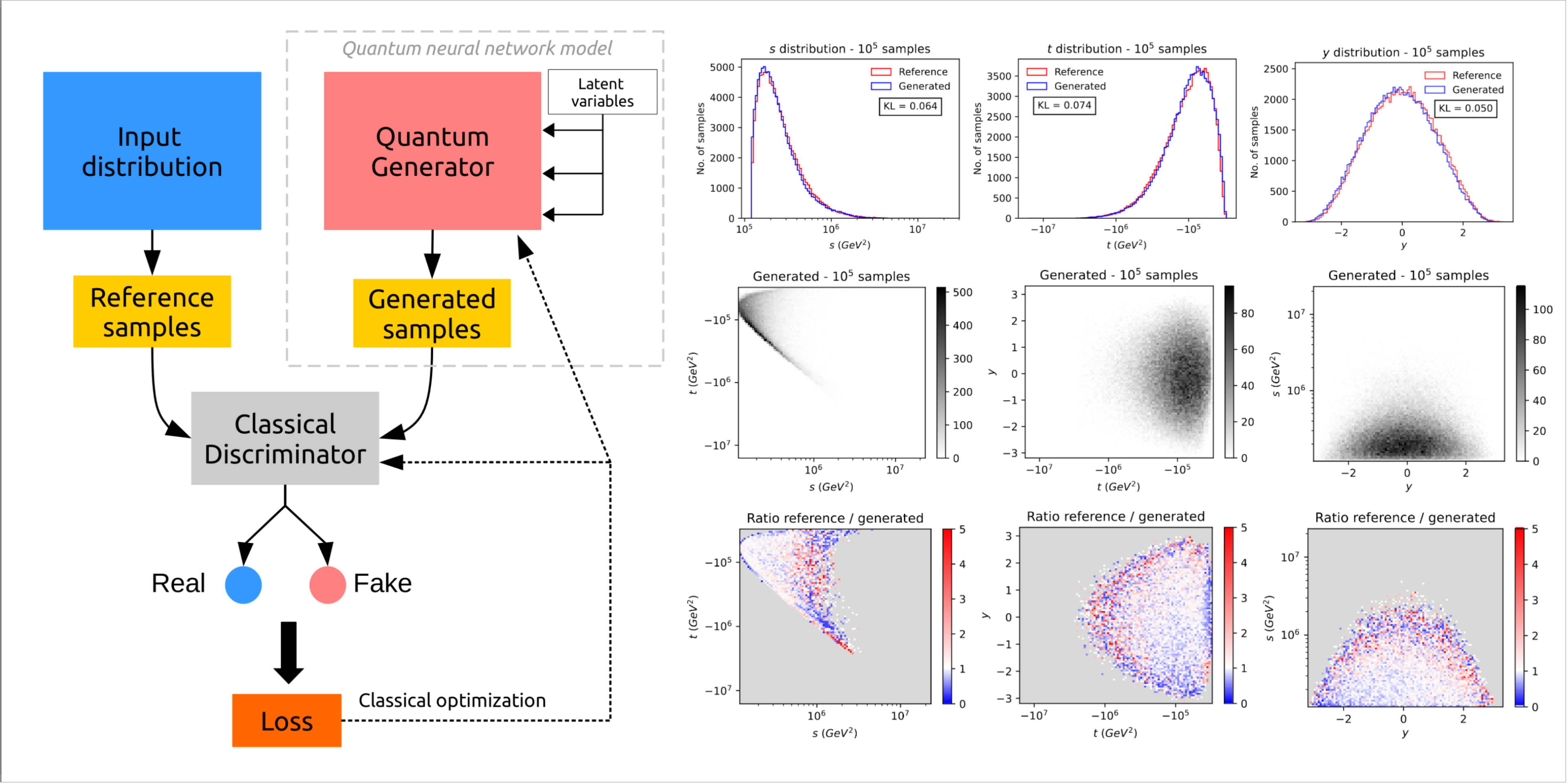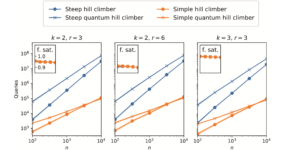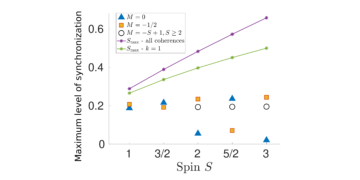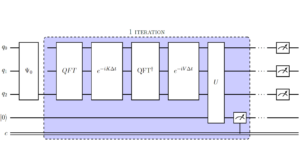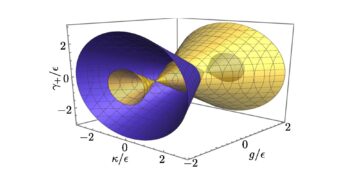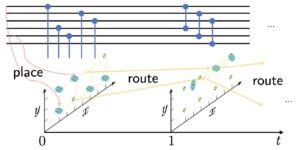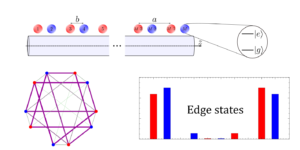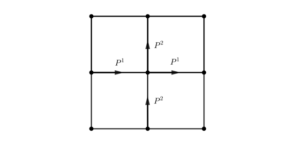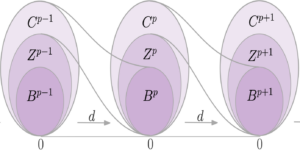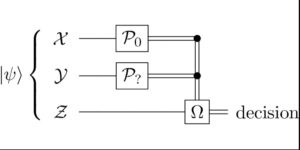1Quantenforschungszentrum, Technology Innovation Institute, Abu Dhabi, Vereinigte Arabische Emirate
2Departament de Física Quantica i Astrofísica und Institut de Ciències del Cosmos (ICCUB), Universitat de Barcelona, Barcelona, Spanien.
3Abteilung für Theoretische Physik, CERN, CH-1211 Genf 23, Schweiz.
4Institut für Physik, National Yang Ming Chiao Tung University, Hsinchu 30010, Taiwan.
5TIF Lab, Dipartimento di Fisica, Università degli Studi di Milano und INFN Sezione di Milano, Mailand, Italien.
Findest du dieses Paper interessant oder möchtest du darüber diskutieren? Scite oder hinterlasse einen Kommentar zu SciRate.
Abstrakt
Wir schlagen eine alternative Quantengeneratorarchitektur im Kontext des generativen kontradiktorischen Lernens für die Erzeugung von Monte-Carlo-Ereignissen vor und bewerten sie, die zur Simulation teilchenphysikalischer Prozesse am Large Hadron Collider (LHC) verwendet wird. Wir validieren diese Methodik, indem wir das Quantennetzwerk auf künstlichen Daten implementieren, die aus bekannten zugrunde liegenden Verteilungen generiert wurden. Das Netzwerk wird dann auf Monte-Carlo-generierte Datensätze spezifischer LHC-Streuprozesse angewendet. Die neue Quantengeneratorarchitektur führt zu einer Verallgemeinerung der State-of-the-Art-Implementierungen und erreicht kleinere Kullback-Leibler-Divergenzen selbst bei Netzwerken geringer Tiefe. Darüber hinaus lernt der Quantengenerator erfolgreich die zugrunde liegenden Verteilungsfunktionen, selbst wenn er mit kleinen Trainingsstichprobensätzen trainiert wird; Dies ist besonders interessant für Anwendungen zur Datenerweiterung. Wir setzen diese neuartige Methodik auf zwei verschiedenen Quanten-Hardware-Architekturen ein, der Technologie „Trapped Ion“ und der Supraleitung, um ihre hardwareunabhängige Durchführbarkeit zu testen.
Ausgewähltes Bild: Links schematische Schritte des Style-qGAN-Trainings. Rechts Randprobenverteilungen für die physikalischen Observablen s, t, y in pp -> ttbar-Produktion am LHC für das style-qGAN-Modell.
► BibTeX-Daten
► Referenzen
[1] J. Preskill, Quantum 2, 79 (2018).
https://doi.org/10.22331/q-2018-08-06-79
[2] F. Arute, K. Arya, R. Babbush, D. Bacon, JC Bardin, R. Barends, R. Biswas, S. Boixo, FGSL Brandao, DA Buell, et al., Nature 574, 505 (2019).
https://doi.org/10.1038/s41586-019-1666-5
[3] H.-S. Zhong, H. Wang, Y.-H. Deng, M.-C. Chen, L.-C. Peng, Y.-H. Luo, J. Qin, D. Wu, X. Ding, Y. Hu, et al., Science 370, 1460 (2020).
https: / / doi.org/ 10.1126 / science.abe8770
[4] M. Cerezo, A. Arrasmith, R. Babbush, SC Benjamin, S. Endo, K. Fujii, JR McClean, K. Mitarai, X. Yuan, L. Cincio et al., Nature Reviews Physics 3, 625–644 (2021).
https://doi.org/10.1038/s42254-021-00348-9
[5] K. Bharti, A. Cervera-Lierta, TH Kyaw, T. Haug, S. Alperin-Lea, A. Anand, M. Degroote, H. Heimonen, JS Kottmann, T. Menke, W.-K. Mok, S. Sim, L.-C. Kwek und A. Aspuru-Guzik, Reviews of Modern Physics 94, 015004 (2022).
https: / / doi.org/ 10.1103 / RevModPhys.94.015004
[6] J. Biamonte, P. Wittek, N. Pancotti, P. Rebentrost, N. Wiebe und S. Lloyd, Nature 549, 195 (2017).
https: / / doi.org/ 10.1038 / nature23474
[7] M. Schuld und F. Petruccione, Überwachtes Lernen mit Quantencomputern, Bd. 17 (Springer, 2018).
https://doi.org/10.1007/978-3-319-96424-9
[8] N. Wiebe, D. Braun und S. Lloyd, Physical Review Letters 109, 050505 (2012).
https://doi.org/ 10.1103/PhysRevLett.109.050505
[9] S. Lloyd, M. Mohseni und P. Rebentrost, arXiv-Vorabdruck arXiv:1307.0411 (2013).
https:///doi.org/10.48550/arXiv.1307.0411
arXiv: 1307.0411
[10] P. Rebentrost, M. Mohseni und S. Lloyd, Physical Review Letters 113, 130503 (2014).
https://doi.org/ 10.1103/physrevlett.113.130503
[11] I. Kerenidis und A. Prakash, Physical Review A 101, 022316 (2020).
https: / / doi.org/ 10.1103 / PhysRevA.101.022316
[12] AW Harrow, A. Hassidim und S. Lloyd, Physical Review Letters 103, 150502 (2009).
https://doi.org/ 10.1103/PhysRevLett.103.150502
[13] M. Benedetti, E. Lloyd, S. Sack und M. Fiorentini, Quantum Science and Technology 4, 043001 (2019a).
https://doi.org/10.1088/2058-9565/ab4eb5
[14] S. Sim, PD Johnson und A. Aspuru-Guzik, Advanced Quantum Technologies 2, 1900070 (2019).
https: / / doi.org/ 10.1002 / qute.201900070
[15] C. Bravo-Prieto, J. Lumbreras-Zarapico, L. Tagliacozzo und JI Latorre, Quantum 4, 272 (2020).
https://doi.org/10.22331/q-2020-05-28-272
[16] M. Larocca, N. Ju, D. García-Martín, PJ Coles und M. Cerezo, arXiv-Vorabdruck arXiv:2109.11676 (2021).
https:///doi.org/10.48550/arXiv.2109.11676
arXiv: 2109.11676
[17] M. Schuld, R. Sweke und JJ Meyer, Physical Review A 103, 032430 (2021).
https: / / doi.org/ 10.1103 / PhysRevA.103.032430
[18] T. Goto, QH Tran und K. Nakajima, Physical Review Letters 127, 090506 (2021).
https://doi.org/ 10.1103/PhysRevLett.127.090506
[19] A. Pérez-Salinas, D. López-Núñez, A. García-Sáez, P. Forn-Díaz und JI Latorre, Physical Review A 104, 012405 (2021).
https: / / doi.org/ 10.1103 / PhysRevA.104.012405
[20] V. Havlíček, AD Córcoles, K. Temme, AW Harrow, A. Kandala, JM Chow und JM Gambetta, Nature 567, 209 (2019).
https://doi.org/10.1038/s41586-019-0980-2
[21] M. Schuld, A. Bocharov, KM Svore und N. Wiebe, Physical Review A 101, 032308 (2020).
https: / / doi.org/ 10.1103 / physreva.101.032308
[22] A. Pérez-Salinas, A. Cervera-Lierta, E. Gil-Fuster und JI Latorre, Quantum 4, 226 (2020).
https://doi.org/10.22331/q-2020-02-06-226
[23] T. Dutta, A. Pérez-Salinas, JPS Cheng, JI Latorre und M. Mukherjee, Physical Review A 106, 012411 (2022).
https: / / doi.org/ 10.1103 / PhysRevA.106.012411
[24] J. Romero, JP Olson und A. Aspuru-Guzik, Quantum Science and Technology 2, 045001 (2017).
https: / / doi.org/ 10.1088 / 2058-9565 / aa8072
[25] A. Pepper, N. Tischler und GJ Pryde, Physical Review Letters 122, 060501 (2019).
https://doi.org/ 10.1103/PhysRevLett.122.060501
[26] C. Bravo-Prieto, Maschinelles Lernen: Wissenschaft und Technologie 2, 035028 (2021).
https:///doi.org/10.1088/2632-2153/ac0616
[27] C. Cao und X. Wang, Physical Review Applied 15, 054012 (2021).
https: / / doi.org/ 10.1103 / PhysRevApplied.15.054012
[28] M. Benedetti, D. Garcia-Pintos, O. Perdomo, V. Leyton-Ortega, Y. Nam und A. Perdomo-Ortiz, npj Quantum Information 5, 1 (2019b).
https://doi.org/10.1038/s41534-019-0157-8
[29] KE Hamilton, EF Dumitrescu und RC Pooser, Physical Review A 99, 062323 (2019).
https: / / doi.org/ 10.1103 / PhysRevA.99.062323
[30] B. Coyle, D. Mills, V. Danos und E. Kashefi, npj Quantum Information 6, 1 (2020).
https://doi.org/10.1038/s41534-020-00288-9
[31] P.-L. Dallaire-Demers und N. Killoran, Physical Review A 98, 012324 (2018).
https: / / doi.org/ 10.1103 / PhysRevA.98.012324
[32] S. Lloyd und C. Weedbrook, Physical Review Letters 121, 040502 (2018).
https://doi.org/ 10.1103/PhysRevLett.121.040502
[33] I. Goodfellow, J. Pouget-Abadie, M. Mirza, B. Xu, D. Warde-Farley, S. Ozair, A. Courville und Y. Bengio, Communications of the ACM 63, 139–144 (2020).
https: / / doi.org/ 10.1145 / 3422622
[34] C. Zoufal, A. Lucchi und S. Woerner, npj Quantum Information 5, 1 (2019).
https://doi.org/10.1038/s41534-019-0223-2
[35] J. Zeng, Y. Wu, J.-G. Liu, L. Wang und J. Hu, Physical Review A 99, 052306 (2019).
https: / / doi.org/ 10.1103 / PhysRevA.99.052306
[36] H. Situ, Z. He, Y. Wang, L. Li und S. Zheng, Information Sciences 538, 193 (2020).
https:///doi.org/10.1016/j.ins.2020.05.127
[37] L. Hu, S.-H. Wu, W. Cai, Y. Ma, X. Mu, Y. Xu, H. Wang, Y. Song, D.-L. Deng, C.-L. Zou, et al., Science Advances 5, eaav2761 (2019).
https: / / doi.org/ 10.1126 / sciadv.aav2761
[38] M. Benedetti, E. Grant, L. Wossnig und S. Severini, New Journal of Physics 21, 043023 (2019c).
https://doi.org/10.1088/1367-2630/ab14b5
[39] J. Romero und A. Aspuru-Guzik, Advanced Quantum Technologies 4, 2000003 (2021).
https: / / doi.org/ 10.1002 / qute.202000003
[40] MY Niu, A. Zlokapa, M. Broughton, S. Boixo, M. Mohseni, V. Smelyanskyi und H. Neven, Physical Review Letters 128, 220505 (2022).
https://doi.org/ 10.1103/PhysRevLett.128.220505
[41] T. Karras, S. Laine und T. Aila, IEEE Transactions on Pattern Analysis and Machine Intelligence 43, 4217 (2021).
https: / / doi.org/ 10.1109 / TPAMI.2020.2970919
[42] A. Pérez-Salinas, J. Cruz-Martinez, AA Alhajri und S. Carrazza, Physical Review D 103, 034027 (2021).
https://doi.org/ 10.1103/PhysRevD.103.034027
[43] W. Guan, G. Perdue, A. Pesah, M. Schuld, K. Terashi, S. Vallecorsa und J.-R. Vlimant, Maschinelles Lernen: Wissenschaft und Technologie 2, 011003 (2021).
https:///doi.org/10.1088/2632-2153/abc17d
[44] SY Chang, S. Vallecorsa, EF Combarro und F. Carminati, arXiv-Vorabdruck arXiv:2101.11132 (2021a).
https:///doi.org/10.48550/arXiv.2101.11132
arXiv: 2101.11132
[45] SY Chang, S. Herbert, S. Vallecorsa, EF Combarro und R. Duncan, EPJ Web of Conferences 251, 03050 (2021b).
https:///doi.org/10.1051/epjconf/202125103050
[46] V. Belis, S. González-Castillo, C. Reissel, S. Vallecorsa, EF Combarro, G. Dissertori und F. Reiter, EPJ Web of Conferences 251, 03070 (2021).
https:///doi.org/10.1051/epjconf/202125103070
[47] GR Khattak, S. Vallecorsa, F. Carminati und GM Khan, The European Physical Journal C 82, 1 (2022).
https://doi.org/10.1140/epjc/s10052-022-10258-4
[48] P. Baldi, L. Blecher, A. Butter, J. Collado, JN Howard, F. Keilbach, T. Plehn, G. Kasieczka und D. Whiteson, arXiv-Vorabdruck arXiv:2012.11944 (2021).
https:///doi.org/10.48550/arXiv.2012.11944
arXiv: 2012.11944
[49] M. Backes, A. Butter, T. Plehn und R. Winterhalder, SciPost Physics 10, 89 (2021).
https: / / doi.org/ 10.21468 / SciPostPhys.10.4.089
[50] A. Butter und T. Plehn, in Artificial Intelligence For High Energy Physics (World Scientific, 2022), S. 191–240.
https: / / doi.org/ 10.1142 / 9789811234033_0007
[51] A. Butter, S. Diefenbacher, G. Kasieczka, B. Nachman und T. Plehn, SciPost Physics 10, 139 (2021).
https: / / doi.org/ 10.21468 / SciPostPhys.10.6.139
[52] A. Butter, T. Plehn und R. Winterhalder, SciPost Physics Core 3, 9 (2020).
https://doi.org/10.21468/SciPostPhysCore.3.2.009
[53] M. Bellagente, A. Butter, G. Kasieczka, T. Plehn und R. Winterhalder, SciPost Physics 8, 70 (2020).
https: / / doi.org/ 10.21468 / SciPostPhys.8.4.070
[54] A. Butter, T. Plehn und R. Winterhalder, SciPost Physics 7, 75 (2019).
https: / / doi.org/ 10.21468 / SciPostPhys.7.6.075
[55] S. Efthymiou, S. Ramos-Calderer, C. Bravo-Prieto, A. Pérez-Salinas, D. García-Martín, A. Garcia-Saez, JI Latorre und S. Carrazza, Quantum Science and Technology 7, 015018 ( 2021a).
https://doi.org/10.1088/2058-9565/ac39f5
[56] S. Efthymiou, S. Carrazza, S. Ramos, bpcarlos, AdrianPerezSalinas, D. García-Martín, Paul, J. Serrano und atomicprinter, qiboteam/qibo: Qibo 0.1.6-rc1 (2021b).
https: / / doi.org/ 10.5281 / zenodo.5088103
[57] M. Abadi, A. Agarwal, P. Barham, E. Brevdo, Z. Chen, C. Citro, GS Corrado, A. Davis, J. Dean, M. Devin et al., TensorFlow: Groß angelegtes maschinelles Lernen on heterogeneous systems (2015), Software erhältlich bei tensorflow.org.
https: // www.tensorflow.org/
[58] afrancis heplat, C. Bravo-Prieto, S. Carrazza, M. Cè, J. Baglio und dm grabowska, Qti-th/style-qgan: v1.0.0 (2021).
https: / / doi.org/ 10.5281 / zenodo.5567077
[59] MD Zeiler, arXiv-Vorabdruck arXiv:1212.5701 (2012).
https:///doi.org/10.48550/arXiv.1212.5701
arXiv: 1212.5701
[60] M. Ostaszewski, E. Grant und M. Benedetti, Quantum 5, 391 (2021).
https://doi.org/10.22331/q-2021-01-28-391
[61] S. Kullback und RA Leibler, The Annals of Mathematical Statistics 22, 79 (1951).
https: / / doi.org/ 10.1214 / aoms / 1177729694
[62] M. Frid-Adar, E. Klang, M. Amitai, J. Goldberger und H. Greenspan, 2018 IEEE 15th International Symposium on Biomedical Imaging (ISBI 2018) (2018), S. 289–293.
https:///doi.org/10.1109/ISBI.2018.8363576
[63] FHK dos Santos Tanaka und C. Aranha, arXiv-Vorabdruck arXiv:1904.09135 (2019).
https:///doi.org/10.48550/arXiv.1904.09135
arXiv: 1904.09135
[64] J. Alwall, R. Frederix, S. Frixione, V. Hirschi, F. Maltoni, O. Mattelaer, HS Shao, T. Stelzer, P. Torrielli und M. Zaro, Journal of High Energy Physics 07, 079 (2014). ).
https: // doi.org/ 10.1007 / JHEP07 (2014) 079
[65] R. Frederix, S. Frixione, V. Hirschi, D. Pagani, HS Shao und M. Zaro, Journal of High Energy Physics 07, 185 (2018).
https: // doi.org/ 10.1007 / JHEP07 (2018) 185
[66] ICH K. Yeo und RA Johnson, Biometrika 87, 954 (2000).
https: / / doi.org/ 10.1093 / biomet / 87.4.954
[67] F. Pedregosa, G. Varoquaux, A. Gramfort, V. Michel, B. Thirion, O. Grisel, M. Blondel, P. Prettenhofer, R. Weiss, V. Dubourg, J. Vanderplas, A. Passos, D. Cournapeau, M. Brucher, M. Perrot und E. Duchesnay, Journal of Machine Learning Research 12, 2825–2830 (2011).
https: / / dl.acm.org/ doi / 10.5555 / 1953048.2078195
[68] G. Aleksandrowicz, T. Alexander, P. Barkoutsos, L. Bello, Y. Ben-Haim, D. Bucher, FJ Cabrera-Hernández, J. Carballo-Franquis, A. Chen, C.-F. Chen, et al., Qiskit: An Open-Source Framework for Quantum Computing (2019).
https: / / doi.org/ 10.5281 / zenodo.2562111
Zitiert von
[1] Travis S. Humble, Andrea Delgado, Raphael Pooser, Christopher Seck, Ryan Bennink, Vicente Leyton-Ortega, C. -C. Joseph Wang, Eugene Dumitrescu, Titus Morris, Kathleen Hamilton, Dmitry Lyakh, Prasanna Date, Yan Wang, Nicholas A. Peters, Katherine J. Evans, Marcel Demarteau, Alex McCaskey, Thien Nguyen, Susan Clark, Melissa Reville, Alberto Di Meglio, Michele Grossi, Sofia Vallecorsa, Kerstin Borras, Karl Jansen und Dirk Krücker, „Snowmass White Paper: Quantum Computing Systems and Software for High-Energy Physics Research“, arXiv: 2203.07091.
[2] Andreas Adelmann, Walter Hopkins, Evangelos Kourlitis, Michael Kagan, Gregor Kasieczka, Claudius Krause, David Shih, Vinicius Mikuni, Benjamin Nachman, Kevin Pedro und Daniel Winklehner, „Neue Richtungen für Ersatzmodelle und differenzierbare Programmierung für die Hochenergiephysik Detektorsimulation“, arXiv: 2203.08806.
[3] Andrea Delgado, Kathleen E. Hamilton, Prasanna Date, Jean-Roch Vlimant, Duarte Magano, Yasser Omar, Pedrame Bargassa, Anthony Francis, Alessio Gianelle, Lorenzo Sestini, Donatella Lucchesi, Davide Zuliani, Davide Nicotra, Jacco de Vries, Dominica Dibenedetto, Miriam Lucio Martinez, Eduardo Rodrigues, Carlos Vazquez Sierra, Sofia Vallecorsa, Jesse Thaler, Carlos Bravo-Prieto, su Yeon Chang, Jeffrey Lazar und Carlos A. Argüelles, „Quantum Computing for Data Analysis in High-Energy Physics“ , arXiv: 2203.08805.
[4] Yuxuan Du, Zhuozhuo Tu, Bujiao Wu, Xiao Yuan und Dacheng Tao, „Power of Quantum Generative Learning“, arXiv: 2205.04730.
[5] Stefano Carrazza, Stavros Efthymiou, Marco Lazzarin und Andrea Pasquale, „Ein modulares Open-Source-Framework für Quantencomputing“, arXiv: 2202.07017.
[6] Sandra Nguemto und Vicente Leyton-Ortega, „Re-QGAN: ein optimiertes Lernrahmenwerk für gegnerische Quantenschaltungen“, arXiv: 2208.02165.
[7] Gabriele Agliardi, Michele Grossi, Mathieu Pellen und Enrico Prati, „Quantenintegration von Elementarteilchenprozessen“, Physikbriefe B 832, 137228 (2022).
[8] Jack Y. Araz und Michael Spannowsky, „Klassik versus Quantum: Vergleich Tensornetzwerk-basierter Quantenschaltungen anhand von LHC-Daten“, arXiv: 2202.10471.
[9] Andrea Delgado und Kathleen E. Hamilton, „Unüberwachtes Quantenschaltkreislernen in der Hochenergiephysik“, arXiv: 2203.03578.
[10] Sulaiman Alvi, Christian Bauer und Benjamin Nachman, „Quantum Anomaly Detection for Collider Physics“, arXiv: 2206.08391.
[11] Oriel Kiss, Michele Grossi, Enrique Kajomovitz und Sofia Vallecorsa, „Conditional Born machine for Monte Carlo events generation“, arXiv: 2205.07674.
Die obigen Zitate stammen von SAO / NASA ADS (Zuletzt erfolgreich aktualisiert am 2022, 08:18:08 Uhr). Die Liste ist möglicherweise unvollständig, da nicht alle Verlage geeignete und vollständige Zitationsdaten bereitstellen.
On Der von Crossref zitierte Dienst Es wurden keine Daten zum Zitieren von Werken gefunden (letzter Versuch 2022-08-18 08:19:33).
Dieses Papier ist in Quantum unter dem veröffentlicht Creative Commons Namensnennung 4.0 International (CC BY 4.0) Lizenz. Das Copyright verbleibt bei den ursprünglichen Copyright-Inhabern wie den Autoren oder deren Institutionen.

